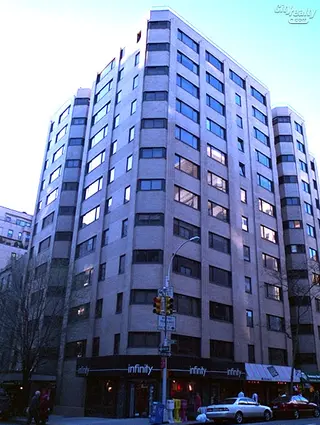 Carter Horsley
Carter HorsleyDec 23, 2011
Carter's Review
An interesting "modern" apartment building, this 12-story, beige-brick apartment building was built in 1938 and converted to a cooperative in 1983. It has 54 apartments.
Designed by Frederick Lee Ackerman, it was the first residential building in New York to offer central air-conditioning, according to Andrew Alpern, who devotes a chapter, entitled "Prewar Pioneer," to it in his fine book, "Historic Manhattan Apartment Houses," (Dover Publications, Inc., 1996).
The system had two equipment rooms on each floor and every apartment had a summer and winter thermostats. Working with Sullivan A. S. Patorno, a consulting engineer, the architect experimented with several innovations. Alpern maintained that the greatest was "the use of mechanically cooled condenser water rather than city-supplied cold water." In addition, the building provided electric stoves and refrigerators and electric heaters in each bathroom and had "an internal radio aerial system with outlets in each unit, which could receive the new television transmissions as well," Alpern noted.
Special attention was also paid to soundproofing and the building originally employed glass blocks in its corner windows. "This cut down on street noise and brought large amounts of diffused light thought the expansive openings without sacrificing privacy. It also disguised the lack of important views and reduced the solar heat load that the air-conditioning system had to handle. Glass blocks were used to build an enclosed rooftop sunroom (in place of a more usual penthouse apartment). In addition, the roof had a game parlor and a small children's play area," Alpern wrote.
In 1986, the building underwent a major alteration that replaced the glass blocks and the casement windows with modern, insulated windows. Alpern notes that "Unfortunately, 25 East 83rd Street was too far north to be protected by the East Side Historic District, and was studiously excluded when the lines were drawn in 1977 for the Metropolitan Museum Historic District." While there is no question that the original façades with the glass blocks gave the building a much more monumental and jewel-like appearance, the new windows are not terrible. It would have been nice, of course, if the chamfered corner at Madison Avenue could have retained the glass blocks.
The building's form is very good. The sidestreet entrance and the façade above it is set back with angled bays and the entrance itself has curved terrazzo walls. The Madison Avenue frontage has a notched indentation near its north end to provide more corner windows.
The building has a very desirable location one block north of P. S. 6, one of the city's finest public schools. There is good shopping in the vicinity and excellent cross-town bus service at 86th Street. The building has no garage, no balconies, no sidewalk landscaping and no health club. It has a small lobby with a concierge and glass entrance doors, which are not too beautiful.
The window pattern has small high windows, a design that has surprisingly not been much copied. Such windows provide light, and, if operable, ventilation but also provide much needed usable wall space.
Carter B. Horsley

- Co-op built in 1963
- 1 apartment currently for sale ($1.65M)
- Located in Carnegie Hill
- 54 total apartments 54 total apartments
- 10 recent sales ($780K to $4.1M)
- Doorman
- Pets Allowed

 6sqft delivers the latest on real estate, architecture, and design, straight from New York City.
6sqft delivers the latest on real estate, architecture, and design, straight from New York City.
